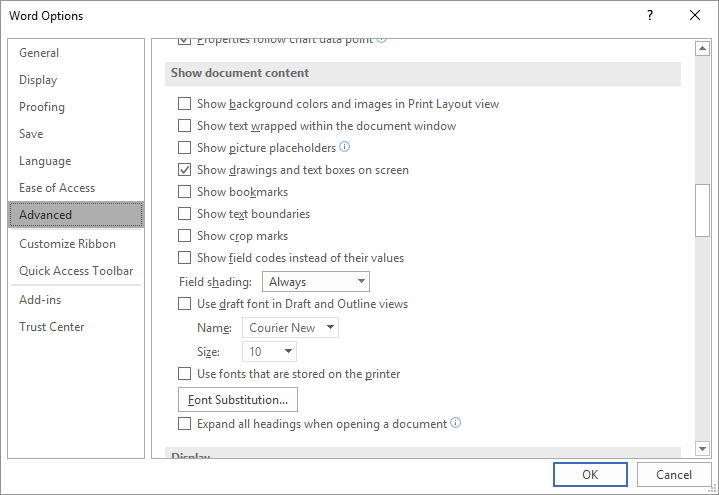Please Note: This article is written for users of the following Microsoft Word versions: 2007, 2010, 2013, 2016, 2019, 2021, and Word in Microsoft 365. If you are using an earlier version (Word 2003 or earlier), this tip may not work for you. For a version of this tip written specifically for earlier versions of Word, click here: Text Doesn't Wrap at Margin in Normal View.
Written by Allen Wyatt (last updated December 31, 2022)
This tip applies to Word 2007, 2010, 2013, 2016, 2019, 2021, and Word in Microsoft 365
Dave recently upgraded his copy of Word and noticed that the text displayed in Draft view wraps on the screen differently than it used to. In his earlier version of Word the text would wrap at the right margin, as it was shown on the Ruler. In the newer version the text extended past the right margin (as shown on the Ruler) and only wraps when the right side of the document window is reached.
The problem being described isn't really a problem. It is a "feature" of Word that has been available for many, many years. You can control this feature by following these steps:

Figure 1. The advanced options in the Word Options dialog box.
The check box in step 4, when selected, makes the text in Draft and Outline views extend the full width of the document window, without regard to where the margin is set. This only affects what you see on the screen; it does not affect any printouts. If the check box is cleared, then the margins are minded and the text wraps where you expect it to wrap.
The need for this feature is rooted in history. The original intent of Draft view (which used to be called Normal view) was to speed up work by foregoing an exact WYSIWYG format. In this view, Word does not worry about line breaks, margins and page breaks in the same manner as in the Print Layout view. Likewise, graphics objects are not displayed. The point is to release computer resources to facilitate doing the work of entering and editing content. The purpose of the Show Text Wrapped Within the Document Window setting is to allow even more information to appear on-screen, since WYSIWYG isn't being paid attention to in Draft view anyway.
It is not unusual for people, these days, to bypass using Draft view and instead using Print Layout view. The Show Text Wrapped Within the Document Window setting has no bearing on this view, since the essence of Print Layout view is to show a very close representation of what your final printout will look like. If you want to use Draft view, there is nothing wrong with that (I do it all the time), but you'll need to pay attention to settings such as the Show Text Wrapped Within the Document Window check box so that your display looks like you want it to.
WordTips is your source for cost-effective Microsoft Word training. (Microsoft Word is the most popular word processing software in the world.) This tip (10690) applies to Microsoft Word 2007, 2010, 2013, 2016, 2019, 2021, and Word in Microsoft 365. You can find a version of this tip for the older menu interface of Word here: Text Doesn't Wrap at Margin in Normal View.

Create Custom Apps with VBA! Discover how to extend the capabilities of Office 365 applications with VBA programming. Written in clear terms and understandable language, the book includes systematic tutorials and contains both intermediate and advanced content for experienced VB developers. Designed to be comprehensive, the book addresses not just one Office application, but the entire Office suite. Check out Mastering VBA for Microsoft Office 365 today!
Abbreviations appear all over the place in our society. If you want to understand how Word recognizes them (which it has ...
Discover MoreIf you inadvertently move to the end of the document, you might be wondering how to get your insertion point back to ...
Discover MoreMany word processing programs include commands that allow you to select a line of text. Word doesn't, but you can use the ...
Discover MoreFREE SERVICE: Get tips like this every week in WordTips, a free productivity newsletter. Enter your address and click "Subscribe."
There are currently no comments for this tip. (Be the first to leave your comment—just use the simple form above!)
Got a version of Word that uses the ribbon interface (Word 2007 or later)? This site is for you! If you use an earlier version of Word, visit our WordTips site focusing on the menu interface.
Visit the WordTips channel on YouTube
FREE SERVICE: Get tips like this every week in WordTips, a free productivity newsletter. Enter your address and click "Subscribe."
Copyright © 2025 Sharon Parq Associates, Inc.
Comments